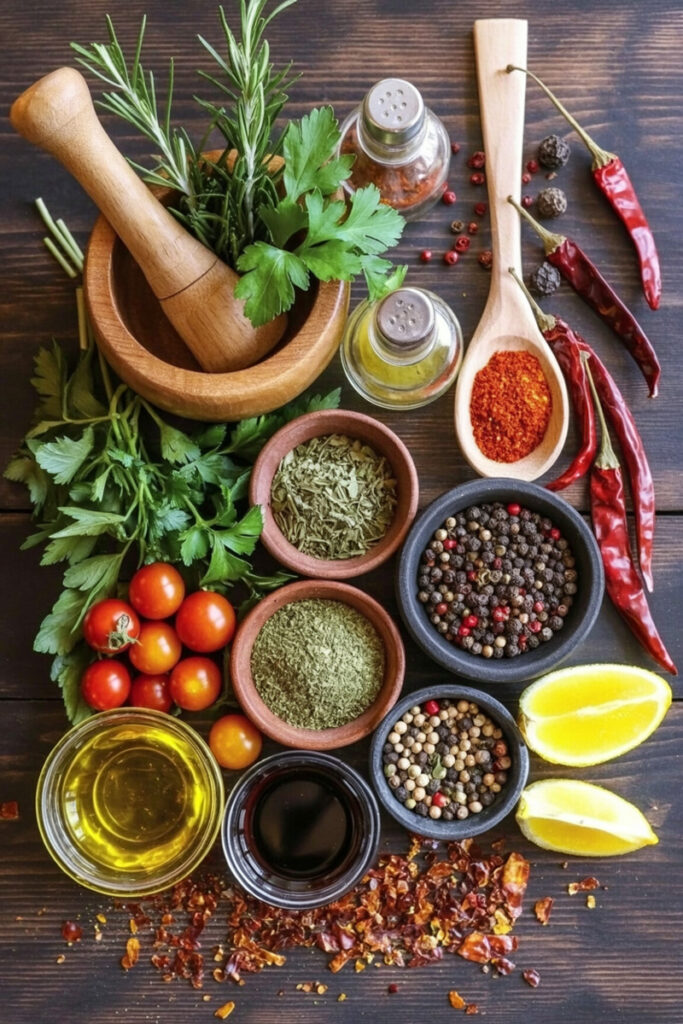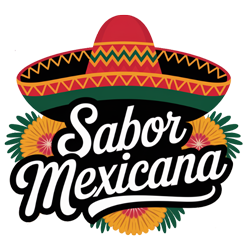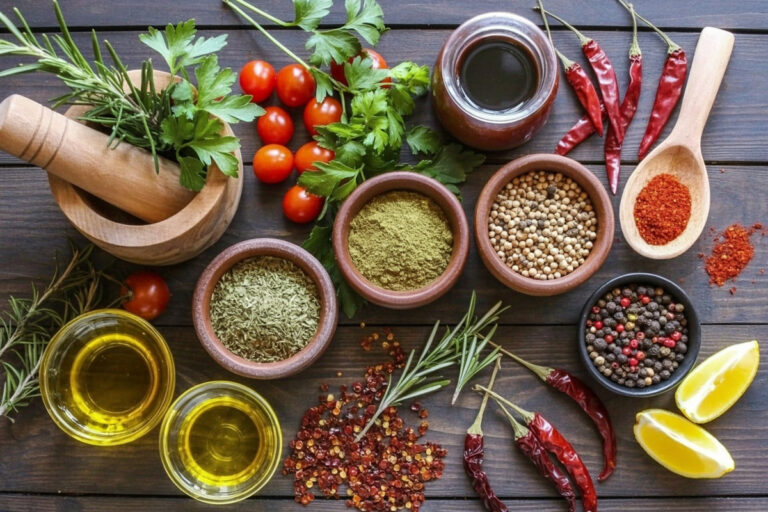The cuisines of Mexico and the Caribbean share more than just geography. Their flavors are bound by history, migration, trade, and a deep reverence for spices that do far more than season food—they tell cultural stories. Together, Mexican and Caribbean cooking form a rich culinary dialogue, where earthy, smoky, citrusy, and aromatic notes create dishes that are as vibrant as the landscapes they come from.
This article explores the defining spices and flavor traditions of both regions, highlighting their shared elements, unique signatures, and the ways they merge into a flavorful crossroads.
The Mexican Flavor Palette
Chiles: The Beating Heart of Mexican Cuisine
No spice defines Mexico more than the chile pepper. From the smoky ancho and pasilla to the fiery habanero, Mexican chiles bring far more than heat. Each variety carries its own flavor personality—sweet, fruity, earthy, or sharp—and they are used fresh, dried, roasted, or ground into sauces and marinades.
In dishes like mole poblano, the chile is not just a seasoning but a canvas of taste, layered with nuts, seeds, spices, and even chocolate. In salsas, chiles transform simple tomatoes and tomatillos into something complex and alive. Their versatility makes them the anchor of Mexico’s culinary identity.
Achiote: The Earthy Red Spice
Also known as annatto, achiote is a spice with Mayan roots that straddles Mexican and Caribbean kitchens. Its earthy, peppery notes and striking red hue color Yucatán specialties like cochinita pibil, where pork is marinated in recado rojo—a paste of achiote, garlic, vinegar, and citrus—before being slow-roasted in banana leaves. Achiote symbolizes the indigenous flavors that remain central to Mexican regional cooking, while also hinting at Caribbean connections.

Aromatic Layers: Cinnamon, Cumin, and Oregano
Though chiles dominate, Mexican cooking leans on a supporting cast of spices that deepen its complexity.
- Mexican cinnamon (canela) adds warmth to both savory moles and sweet arroz con leche.
- Cumin, introduced by the Spanish, became a foundation for soups, beans, and spice pastes.
- Mexican oregano, sharper and more citrusy than its Mediterranean cousin, lends brightness to salsas and stews.
Together, these spices round out the chile-forward backbone of Mexican flavor.
Modern Spice Innovation: Tajín
Mexico has never stopped innovating with flavor. Tajín, a blend of ground chiles, lime, and salt, represents a modern classic. Sprinkled on mango, cucumbers, or even cocktails like micheladas, Tajín captures the essence of Mexican spice philosophy: bold, tangy, and playful.
The Caribbean Spice Story
Allspice: The Quintessential Caribbean Flavor
If chiles define Mexico, allspice defines the Caribbean. Known locally as pimento, this native berry carries notes of cinnamon, nutmeg, and clove all in one. It is the soul of Jamaican jerk seasoning, balancing fiery Scotch bonnet peppers with sweet warmth. Beyond jerk, allspice appears in stews, marinades, and even desserts, embodying the region’s tropical, layered flavor profile.
Garlic, Cumin, and Coriander: The Everyday Staples
Much like in Mexico, Caribbean cooks rely on garlic, cumin, and coriander. These spices form the foundation of sofritos and adobos, flavoring beans, meats, and seafood. Garlic in particular is indispensable, sautéed into almost every dish to release its pungent aroma and savory depth.
Warming Spices: Nutmeg, Clove, and Cinnamon
The Caribbean spice cabinet reflects centuries of trade and colonization. Nutmeg and cloves, brought from the East Indies, settled into local traditions, often seasoning baked goods, drinks, and savory marinades. Cinnamon, too, migrated into the Caribbean kitchen, where it infuses everything from curries to plantain desserts. These sweet spices are used more liberally in the Caribbean than in Mexico, adding a warmth and richness that balances tropical acidity.
Ginger and Scotch Bonnets: Fire Meets Citrus
Ginger, with its sharp zing, is widely used across the islands, adding brightness to sauces, stews, and teas. But the Scotch bonnet pepper is the true fire of the Caribbean. Comparable in heat to the habanero, it carries a distinctive fruity, citrusy punch. In jerk marinades, combined with allspice and thyme, it creates the unmistakable taste of Caribbean spice: hot, fragrant, and unforgettable.
Adobo: The Ubiquitous Seasoning
Adobo in the Caribbean comes in two forms:
- Dry adobo, a blend of paprika, garlic powder, oregano, and turmeric, functions as a rub for meats and fish.
- Wet adobo, often made with vinegar, citrus juice, garlic, and herbs, doubles as a marinade.
Adobo exemplifies the Caribbean approach to spices: blending local and imported ingredients into practical, flavorful combinations.
Where Mexico and the Caribbean Meet
Though distinct, Mexican and Caribbean kitchens share several key spices—garlic, cumin, coriander, oregano, and achiote—revealing their intertwined histories. Both traditions also emphasize the transformative role of marinades, spice pastes, and rubs, where flavors are built up before cooking even begins.
Achiote as the Bridge
Achiote is perhaps the clearest connection. In Yucatán, it defines recado rojo; in the Caribbean, it is used to color rice, season fish, or flavor stews. Its dual presence tells the story of indigenous roots adapted across borders.
Different Uses of the Same Spices
- Cumin in Mexico often seasons beans and soups, while in the Caribbean it bolsters curries and adobos.
- Oregano in Mexico brings a sharp citrus note, while in the Caribbean it leans more savory and herbal.
- Garlic, ubiquitous in both, takes on different roles: raw and punchy in Mexican salsas, slow-simmered in Caribbean sofritos.
These subtle differences highlight how shared ingredients evolve into distinct flavor identities.
Cultural Layers in Spice Traditions
Indigenous, African, and European Influences
Mexican-Caribbean spice traditions are the product of cultural fusion. Indigenous peoples introduced chiles, achiote, and allspice. African diasporas carried techniques like marinating and grilling, visible in both jerk and barbacoa. European colonizers brought cinnamon, nutmeg, cloves, and cumin, which were adapted into local traditions. The result is two regional cuisines that celebrate diversity through flavor.
Spice as Identity
In both Mexico and the Caribbean, spice is not just a matter of taste but identity. Jerk seasoning speaks to resistance and survival, born in the Maroon communities of escaped enslaved Africans. Mexican moles, with their dozens of ingredients, symbolize celebration and communal labor. Every spice blend carries cultural weight.
Modern Intersections and Global Appeal
Today, Mexican-Caribbean flavors travel far beyond their regions. Tajín has become a global pantry staple; jerk seasoning is celebrated worldwide. Chefs are experimenting with fusion dishes that highlight their shared spice language—for example, tacos filled with jerk chicken, or mole sauces accented with allspice.
In global kitchens, these cuisines offer lessons in balance: heat tempered with sweetness, earthiness lifted by citrus, complexity built from simple roots. Their flavors remind us that spice is more than seasoning—it is history on the tongue.
Conclusion
Mexican and Caribbean cuisines are united by their boldness, their respect for tradition, and their creative use of spices. While Mexico leans on chiles and achiote to shape its earthy, layered flavors, the Caribbean celebrates allspice, ginger, and Scotch bonnets to create fiery, aromatic dishes. Shared staples like garlic, cumin, and oregano bridge the two, while their unique applications keep each cuisine distinct.
For the food lover, understanding these spices opens a door to appreciating not just recipes but the histories, identities, and resilience they represent. Whether in a bowl of Yucatán cochinita pibil or a plate of Jamaican jerk chicken, the flavors of Mexico and the Caribbean remind us that spice is the story of a people—told deliciously.

